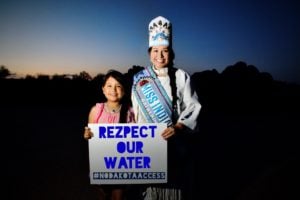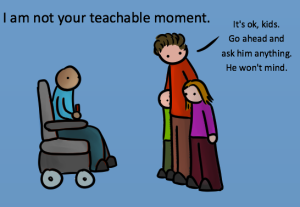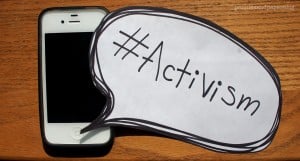
The author’s daughter, Kimimila, and the author’s sister, Ta’Sheena, who is the reigning Miss Indian World and a citizen of the Standing Rock Sioux Tribe, support the anti-pipeline efforts in North Dakota. For more information, visit www.rezpectourwater.com.
More than 90 Indigenous nations and non-Native accomplices have gathered in camps near Cannon Ball, North Dakota, to protect lands, waters, and people from a crude oil pipeline.
The number of supporters has swelled to up to 4,000 at points in the last few weeks, according to on-the-ground estimates, though the numbers ebb and flow.
Thousands more supporters across the US, like myself, have been unable to lend physical support, though we have provided much-needed money, supplies, emotional solidarity, and legal support from afar.
I can’t adequately put into words how historic an Indigenous gathering like this is; something similar happened in 1876, when many Native nations under Sitting Bull, Crazy Horse, and other great leaders came together and defeated Lt. Col. George Armstrong Custer’s 7th Calvary at the Battle of the Greasy Grass (aka Little Bighorn).
That it’s happening again, now, in this time, is momentous.
It’s also a stark reminder of how little has changed for Native nations and our relationship with the US government.
In 1876 we were fighting to protect our sacred lands, specifically Ȟe Sápa, the Black Hills in South Dakota, where Custer led an illegal expedition and found gold, despite the Treaty of Fort Laramie (1868) stating that land belonged to the Očéti Šakówiŋ (the Lakota, Dakota, and Nakota people commonly referred to as the Sioux).
Today, the same government is violating the same treaty. But it’s oil, not gold, that has outsiders rushing to remove resources from occupied Indigenous lands.
In July, the US Army Corps of Engineers authorized the $3.7 billion Dakota Access Pipeline Project (DAPL), which, if constructed, will carry some 470,000 or more barrels of crude oil a day from North Dakota’s Bakken oil fields to a hub in Illinois, where it would go on to reach other refining markets.
The Standing Rock Sioux Tribe has been fighting DAPL since its early planning stages in 2014, when most people were concentrating solely on the now-defunct Keystone XL pipeline. The tribe’s drinking water, as well as sacred cultural sites and economy, are threatened by the pipeline’s route and its construction.
But the fight goes beyond any one “Native” issue. Divesting from fossil fuels to protect our planet’s limited resources, like clean drinking water, is an “everyone” issue.
Yet – not everyone is interested in joining the people of Standing Rock and its allies. Cannon Ball is, like many reservation communities, far away from pretty much everything an urban, contemporary lifestyle demands, like reliable Wi-Fi, Uber, and multiple food and grocery options.
Beyond its physical location, what’s happening in Standing Rock, like most issues affecting Indian Country, impacts too small an audience (at least for the moment) for mainstream media to take notice long-term, if at all.
Native people make up about 2 percent of the total US population; the latest estimates put the Native population living within the Standing Rock reservation at about 6,500; total tribal enrollment is estimated around 15,600 citizens.
In other words, Standing Rock and its Native allies—those 90-plus nations mentioned above—need major accomplice support from non-Natives if our efforts to defeat DAPL are to gain enough media (and therefore political) attention to succeed.
If you’re into solidarity—or clean drinking water, at the bare minimum—the Native nations in Standing Rock need your body, and/or your dollars, and/or your platform to uplift our efforts and our messaging.
Situations on-site occur daily. In general, here’s what you need to know.
1. It’s Not Political – It’s Life and Death
Make no mistake: What the people of Standing Rock and their allies are protecting is life for all our relations, be they human, animal, or plant life.
The proposed route of the DAPL crosses both the Ogallala Aquifer and Missouri River, which provide water for drinking and agriculture (that would be growing the nation’s food) to millions of people. The pipeline crosses the Missouri River just north of Standing Rock’s tribal boundaries; a pipeline break means Native people will be hit first and hardest.
Don’t believe me? Check out this article, which shows how an earlier pipeline route proposed crossing the Missouri River north of Bismarck, the state’s capitol city. That route was rejected because it was a “potential threat to Bismarck’s water supply.”
Non-Native people read that article and were shocked. Native people read that same article and were like, “Welp. Business as usual.” This is the kind of systemic oppression we face on a daily basis.
Native people have always been the collateral damage of a growing nation; our deaths are an acceptable risk in the face of capital gain.
Indeed, the governor of North Dakota, who declared a state of emergency in response to the protests he has referred to as unlawful and unsafe, has a sketchy (if legal) financial interest in seeing this pipeline built and the Bakken oil industry succeed.
With such obstacles to overcome, I’m proud of the protectors’ many achievements and continued commitment to the cause.
A popular movement saying (which has been around in one way or another since… forever) is mní wičóni meaning “water is life” in Lakota.
Many Native nations have similar concepts. For instance, after praying before a large meal, Diné people will pass around a cup of water to sip and bless themselves with in recognition of how important water is and how it connects us all.
These aren’t sayings or practices done on a trendy whim; they have real value and meaning. #AncestorsOnPoint
Fossil fuel extraction, transportation, and use is destroying our planet, and Indigenous people are the most at-risk population, due to the ruralness of our communities and proximity to the pipelines, and our lack of political power and monetary influence.
As primary caregivers and keepers of cultural traditions and practices, Indigenous women are especially vulnerable, and are disproportionately affected by toxic contaminates from things like oil spills and uranium mining, as well as the effects of climate change and hard-to-regulate oil field “man camps” where violence against Native women and girls runs rampant.
Since the time of Columbus we have learned that violence against the land is violence against Indigenous women.
This is why you will always see Native women leading environmental movements.
Our lives depend on it.
2. This Is a Women-Led Issue
Traditionally, the Očéti Šakówiŋ were pretty inclusive, gender-wise, and our women had agency and earned positions of great power and respect.
Enter Western systems of patriarchy and misogyny. Many tribal people got swept into the idea that femininity meant less, though I think we who identify as women and Two Spirit have been slowly but successfully reclaiming our roles within tribal societies as leaders, protectors, warriors, and caregivers.
As mentioned above, Indigenous women are on the front lines of every major issue, from Idle No More’s environmental justice movement in Canada, to ending the use of Native mascots and imagery in sports. Many more examples exist, including language revitalization; health care and education reform; food sovereignty; violence against Indigenous women; climate change; and more.
At the camps in Standing Rock, women-identifying folks are using their bodies and risking arrest to prevent pipeline crews from accessing the construction site, they’re cooking and feeding for thousands, and they’re leading security teams 24/7 to ensure campers safety and adherence to camp guidelines.
They’ve also developed their own school and curriculum for youth staying long-term at the camps. As a former teacher, I can assure you: This is huge.
Considering the disproportionately low rates of Native high school graduates, a move like engages youth where they’re at (literally and socially) and ensures Indigenous knowledge is passed on in ways that work for our own communities.
And it’s not just Indigenous women on the frontlines of this issue. Several non-Native celebrity women have thrown significant support toward anti-DAPL efforts and have used their mighty platforms to raise awareness for tribal water and land rights.
The women of this movement have been humble about their roles and impact.
But we see you. And we thank you.
3. Our Movement Is Non-Violent Direct Action
No guns. No drugs or alcohol. Protect and care for others in the camp.
These are some of the basic guidelines to which everyone involved with the movement, especially those at the camps, must adhere.
Yet local and state authorities have been spreading falsehoods about “safety concerns,” which the media broadcasts without question. This perpetuates the disproportionately high rates of police violence our Native communities already face.
In one instance, the Sheriff of Morton County in North Dakota stated at a press conference there were weapons, including “pipe bombs,” wielded by protesters. The link provided is an example of how the media made no attempt to verify the sheriff’s statements.
Many protectors immediately took to social media to explain how they were loading sacred pipes with tobacco (for prayer and ceremony), not loading pipe bombs with explosives.
You might think such a thing laughable, but these kinds of “misunderstandings” happen all the time (ask me how many police officers I’ve encountered who think smudged sage smells like marijuana) and contribute to an incarceration rate that’s 38 percent higher for Native Americans than the national average.
Already these falsehoods have created extreme tensions.
A concrete barricade assembled by the North Dakota Highway Patrol prevents reservation access on a main thoroughfare. This has chilled an already struggling reservation economy and diverts traffic to and from the camp to potentially unsafe dirt roads. This video shows the utter absurdity of the barricade and police presence. Amnesty International USA has called for an immediate roadblock removal.
Authorities fly surveillance aircraft over the camps, often at night without any kind of warning or notice. The highway patrol claimed campers pointed “lasers” at the pilots (a Dr. Evil-worthy federal offense), which prompted officials to remove state-owned resources, including water tanks, from the camps.
(Funny: Authorities label our protests “unsafe” but have no qualms yanking a main source of drinking water from hundreds to thousands of people, including children and elders, during August temperatures.)
I’m proud to say my tribe, Cheyenne River, came through with more water tanks, though more water is needed.
And over the Labor Day weekend, goons a private security team unleashed attack dogs and mace at protectors, who stormed a site tribal leaders say is sacred land that contains culturally significant artifacts; despite court documents filed to prevent construction there, the site was being bulldozed to further pipeline interests.
Though not one uniformed officer was seen during the clash, the Morton County Sherriff’s Department issued a statement afterward (posted without question by some media outlets) calling the event a “riot” where protesters showed “aggression and violence” toward DAPL’s security officers.
As noted above, the media has, in several instances, ran with stories puppeting whatever authorities tell them (i.e. protester pipe bombs and vandalism), often without any kind of verification or response from the protectors.
I’ve spent the last 13 years as a news media professional; verifying facts is Journalism 101. Especially in North Dakota, these kind of anti-protest (read: anti-Native) stories fuel already shaky race relations (read any of these outlets’ comment sections for proof).
Although several mainstream outlets (here, here, and here, among others) have discussed Indigenous resistance to DAPL, the movement hasn’t garnered the kind of round-the-clock attention someone like rancher Cliven Bundy received when he and hundreds of armed (and mostly white) supporters issued multi-week standoffs with federal authorities in Nevada in 2014 and in Oregon earlier this year.
Additionally, I find it interesting how mainstream media frame what’s happening in Standing Rock; a quick Google News search for “Dakota Access Pipeline” shows militant words like “standoff,” “clash,” “fighting,” and “occupy” are used sensationally within headlines.
(Note: Variations of the word “occupy” are used to describe pipeline protesters, when in fact it is the pipeline and US government illegally occupying our treaty territories.)
With headlines like these, you’d think we were back in an outpost of the savage Wild West. Yes, the stereotype struggle is real.
The important takeaway here is that outsider perceptions have a direct impact on the support the movement receives, and the power mainstream media wields to shape those perceptions is, in a word, scary.
Could there be some unsafe, even threatening behaviors exhibited by protesters at the camps? Sure. Though monitored by volunteer security teams, the camps run a “you’re an adult and can follow the posted rules or leave” operation.
From what I’ve seen and heard from my many friends and relatives in the camps, absolutely nothing has gone down to warrant barricade building, attack dogs, resource removal, sacred site desecration, or false labels by authorities.
But here’s the thing: Reneging assistance, controlling reservation access, and slandering our character doesn’t really shock Natives or anyone who knows their US history.
This kind of system oppression is business-as-usual when it comes to tribal/state/federal relations and has been for hundreds of years. Though we get excited every time a political candidate/president notices us, government-to-government discussions rarely occur or Natives are rarely heard when important topics arise (like approving pipelines that threaten a reservation’s water supply).
In the past, the government controlled Native behaviors by slaughtering our primary food source, the buffalo, to the point of near-extinction. They took our lands, then took the lands they legally promised us (via treaties) as sovereign nations. They took our children and taught and prayed and beat the Native right out of them at boarding schools. And they massacred our people, over and over again.
Now it’s barricades, hired scaremongering, water tanks, and skewed headlines.
The difference is we now have social media to help spread our messages and our demands. We also need non-Natives to help spread our messages and demands.
Just saying: This is a great time for all those who love to “honor” Native people with headdresses and Halloween costumes and sports mascots to prove how much you really care. #winkwinknudgenudge
What You Can Do to Help
While I’m from South Dakota, I actually graduated from Bismarck (ND) High School (class of 2001!) and have family from Standing Rock. While I’m doing my best to support the movement from afar, it’s been hard not to be physically there with my people and other protectors.
Because I think the best way for anyone to help is to be there, in person. It’s also the best way to experience exactly what we’re protecting–and fighting for and fighting against.
If you can make it up to Standing Rock, here’s a great link on what you need to know. Read it. Respect it.
If you’re unable to be there in person, for whatever reason, there are still countless ways to contribute:
- Donate funds directly to the Standing Rock Sioux Tribe, to help protectors at the camps, and assist in the legal defense for those arrested.
- Donate supplies. You can find updated lists of needed items (and where to send them) here and here. Many people have mailed the supplies (or ordered from Amazon) or delivered the supplies themselves.
- Another option to ensure delivery of supplies is to organize or participate in a local donation drive where an agency or individual is responsible for delivery.
- Uplift and share Native-led messaging efforts with your networks. This Facebook page has been actively sharing information, including live video of camp and protest happenings, nationwide donation and solidarity events, and relevant and accurate news stories. In your posts, use the hashtags #NoDAPL #NoBakken #SacredStoneCamp #StopDAPL #MniWiconi #RezpectOurWater and #StandWithStandingRock
- Tell President Obama to reject the DAPL as he did with the Keystone XL pipeline: (202) 456-1111. Demand the US Army Corps of Engineers reverse their DAPL permit decision: (202) 761-5903.
- Contact your representatives and demand legislation to protect Indigenous lands, water, people, and sovereignty.
- Sign the petition to stop the DAPL.
Finally, get involved with what’s happening in your area. Environmental justice is a many-sided effort taking place in Indigenous communities across Turtle Island.
Here are just three examples with recent updates: the Musgamagw Dzawada’enuxw Nation’s opposition to fish farms; the Gila River Indian Community’s push to stop a major freeway expansion through sacred lands; and a Navajo undertaking to halt plans for a multimillion-dollar tourist attraction that threatens a fragile ecosystem at the confluence of Colorado and Little Colorado rivers at the Grand Canyon.
The Indigenous Environmental Network does a good job curating environmental news and activities affecting Indigenous people across North America.
Note: Any accomplice support you provide to Standing Rock or other Indigenous environmental justice issues must be on our terms as Indigenous people. This movement is happening within Native spaces; our cultures, beliefs, and values must be upheld.
***
On Sept. 9, a federal judge will rule on an injunction filed by the Standing Rock Sioux Tribe to stop DAPL construction. Tribal and movement leaders expect many more developments in the coming days, weeks, and months.
Though the immediate need of this movement is to stop the construction of the DAPL, it’s not a large leap to say the fight goes well beyond one pipeline.
This is about Indigenous resurgence, sovereignty, and resilience. This is about the legacy we leave the next seven generations and beyond.
Please join us.
[do_widget id=’text-101′]
Taté Walker is a Contributing Writer for Everyday Feminism. She is Mniconjou Lakota and an enrolled citizen of the Cheyenne River Sioux Tribe. She lives in Phoenix and is the editor of Native Peoples magazine. Contact her at www.jtatewalker.com and read her articles here.
Search our 3000+ articles!
Read our articles about:
Our online racial justice training
Used by hundreds of universities, non-profits, and businesses.
Click to learn more




















